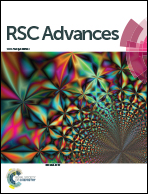Carbon-based dots co-doped with nitrogen and sulfur for Cr(vi) sensing and bioimaging†
Abstract
Less toxic elements nitrogen and sulfur co-doped carbon-based dots (NSCDs) have been prepared by microwave-assisted pyrolysis of citric acid and N-acetyl-L-cysteine as the carbon source and N,S-dopant, respectively. The structure and optical properties of NSCDs are characterized by transmission electron microscopy, X-ray photoelectron spectroscopy, elemental analysis, Fourier transform infrared spectroscopy, UV-vis absorption, and photoluminescence spectroscopy. The mechanism for the formation of NSCDs is also discussed. The as-prepared NSCDs show small size distribution and excellent dispersibility. Their strong blue fluorescence is observed when the excitation wavelength is between 260 nm and 380 nm. Moreover, they exhibit high tolerance to various external conditions including external cations, pH values, and continuous UV excitation. More strikingly, as the emission of NSCDs is efficiently quenched by Cr(VI), the as-prepared NSCDs are employed as a highly sensitive and selective probe for Cr(VI) detection. The linear range is 0.5–125 μM Cr(VI) with the detection limit 20 nM. The as-synthesized NSCDs have been successfully applied for Cr(VI) sensing and cell imaging.


 Please wait while we load your content...
Please wait while we load your content...